The state of marine Ethernet connectors, and hello to RayNet
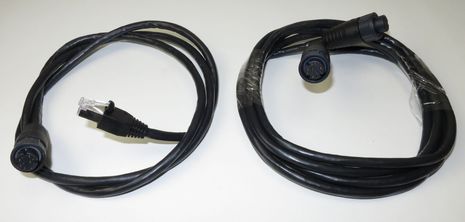 It’s not an exciting photograph, I know, but cables are a fairly big deal when you or your installer get down to the real nitty-gritty of putting a marine electronics system together. While it’s great that the NMEA 2000 cable and connector standard is pretty much taking care of lower speed sensor networks regardless of equipment brands, the sore spot now is the Ethernet cables used for high speed data like radar, sonar, IP cameras, and chart sharing. Though standard Ethernet cables easily connect many different devices in our homes and offices, marine connectors are not standardized. In fact, some Raymarine customers are dealing with two proprietary Ethernet connector designs as the company transitions to the RayNet plugs seen above. But RayNet makes sense to me and shouldn’t cause undue pain once all the available options are understood…
It’s not an exciting photograph, I know, but cables are a fairly big deal when you or your installer get down to the real nitty-gritty of putting a marine electronics system together. While it’s great that the NMEA 2000 cable and connector standard is pretty much taking care of lower speed sensor networks regardless of equipment brands, the sore spot now is the Ethernet cables used for high speed data like radar, sonar, IP cameras, and chart sharing. Though standard Ethernet cables easily connect many different devices in our homes and offices, marine connectors are not standardized. In fact, some Raymarine customers are dealing with two proprietary Ethernet connector designs as the company transitions to the RayNet plugs seen above. But RayNet makes sense to me and shouldn’t cause undue pain once all the available options are understood…
The basic problem is the otherwise ubiquitous Ethernet RJ45 connector. Your house probably has at least a few cables double-ended with male RJ45 connectors like the one above and snapped into network ports on computers, routers, printers, televisions, etc. The plug can snake through a hole about 13mm (1/2″) in diameter, and I’m told that an installer handy with a RJ45 crimping tool can fairly easily run plain cable. In short, the RJ45 generally works fine indoors (regardless of device brand). However, it is not rugged enough to go on the back of a marine multifunction display, let alone a radar, because it’s not at all waterproof and it doesn’t take much of a tug to overcome the little plastic locking mechanism.
While the NMEA is slowly selecting a waterproof marine Ethernet connector standard as part of ongoing OneNet development (which, like NMEA 2000 connectors, will be an existing industrial standard offered by multiple manufacturers), the major brands have already each come up with their own way of doing boat Ethernet. The photo above shows how some are simply RJ45 plugs with a collar system that keeps water out and makes the mechanical connection strong. The first two are the same Garmin Marine Network style, meant to show how the snap-on collar leaves the connector an installer needs to snake through a boat only 24mm (15/16″) in diameter (though Garmin has a neat alternative, discussed below). The middle connector is Raymarine’s old style SeaTalkhs collared RJ45 and then circled in red is the new RayNet connector, which seems designed from the ground up for marine use and thus, has nothing to do with RJ45. Finally there’s Navico’s colorful marine Ethernet plug, also built specifically for the job. Why is Raymarine switching?
Well, some manufacturers support the concept that RJ45 connectors are good enough to use in dry, protected boat spaces, which is evident in the older Raymarine SeaTalkhs (high speed) switch above. In fact, that very switch has been mounted under Gizmo’s flying bridge helm for several years and has happily accepted the RJ45 plugs that came on the end of a Ray radome cable and the inside ends of the old SThs cables that went to an E-Wide MFD and a blackbox DSM sounder, plus the standard cable used to control FLIR cameras (their Ethernet details here) and the RayNet-to-RJ45 cable that came out with the new plug. The 26mm (1+”) diameter of the old SeaTalkhs waterproof connector really didn’t matter because the installer could fish the RJ45 end (at least tape wrapped for protection) or just whack off the inside plug and crimp on a new one after making the run.
However, as marine Ethernet systems got more sophisticated and also started finding their way aboard smaller, less protected boats, Navico and Garmin both developed Ethernet switches that use their waterproof connectors, the Navico NEP-2 and the Garmin GMS 10. So, now Raymarine offers the HS5 SeaTalkhs Network Switch, which also costs about $250. But when you start running cables with waterproof connectors at both ends, their diameter really matters, and that’s one reason the new RayNet plug is the slightly skinnier winner at about 18mm (11/16″) with Navico second at 20mm (13/16″). Then again, none of these connectors is skinny enough in certain situations, radar cables fished through sailboat masts being the most common.
Before discussing Ethernet cable splicing strategies, let’s look at the heavy-duty backside of a Furuno NavNet TZT14. I didn’t have a Furuno Waterproof LAN cable to pose with the others (it’s still installed on Gizmo), but obviously, Furuno uses the collared RJ45 approach. The inside end is standard RJ45, as is their HUB101 switch. As noted, similar Raymarine Ethernet architecture worked fine on my boat, and having RJ45 inside also means you can probably use a regular (and much less expensive) Ethernet switch. Furuno seems particularly open to that option, and I’ve used a nice little 12v NetGear GS105 with both NavNet 3D and TZT. Note, though, that the TZT14 has its own 3 port Ethernet hub. It’s become common now for larger MFDs to have multiple Ethernet ports, and it often means that a separate switch is not necessary. However, on a boat with two helm stations, having a switch may mean you can run radar, sonar, etc. at either helm without having an unused MFD turned on.
As for butt splicing typical Cat 5 Ethernet cable, it’s just not done in polite company! It’s the same problem as fine gauge NMEA 0183 wires except with four twisted pairs of 22-24 gauge solid core wire. You don’t crimp connect them individually and you don’t use a terminal block. The accepted way to join two Ethernet cables is by putting a male RJ45 connector on each end and snapping them both into a female-female coupler. It used to be that if you wanted to connect a Raymarine radar directly to, say, an E-Wide MFD, you used the Crossover Coupler seen in two pieces above (I won’t get into what “crossover” means in Ethernet wiring, largely because current gear doesn’t care). You can use the same coupler with RayNet/RJ45 cables — like the one seen at the top of the entry — but I like the new A80247 Adaptor shown going together above.
Here’s what the waterproof adaptor looks like when screwed together and further accessorized with the new RayNet Right Angle Adaptor, which also doesn’t seem to have reached online stores yet, but can be seen on this Raymarine page. There’s also old SThs connector to RayNet adapters, a RayNet to RayNet Cable Joiner, and even a neat RayNet Cable Puller, which both provides the right place to tie a string and protects the connector pin holes as it travels through your boat’s mast or raceway. Conclusion? RayNet looks like a better marine Ethernet connector than its predecessor, and I don’t think the installer who called me last week after finding himself dealing with both types of SThs connectors on the same new install will feel so frustrated when he sees all the available adaptors.
Actually, that particular installer and many others often turn to Garmin Marine Network parts to solve Ethernet cabling issues even when they don’t involve Garmin gear. That’s because they can buy Garmin waterproof RJ45 plugs they can crimp themselves, plus the Coupler pictured above, which can even be bulkhead mounted (perhaps near your mast step). All of this marine Ethernet gear is fairly expensive, by the way, and the new RayNet cables look especially so. By contrast, that standard RJ45 coupler above costs 56 cents and is doing the job on some boats (possibly wrapped in tape). On the other hand, many boaters don’t want to go cheap on their high speed data networks and some advanced Ethernet capabilities are just coming to marine electronics. The Raymarine gS Series, for instance, uses Power over Ethernet (PoE) to simplify installation of the RMK keypad and IP cameras to come (as I described here).
In fact, if you look closely at the RayNet plug you’ll see that it has 10 pins, which is a minor mystery given the Ethernet norm of 8 wires. Does anyone have a guess about what those two extra pins do, or will eventually do?
Finally, I’d like to close with a shot of Raymarine’s A06046 N2K (DeviceNet) Male Adaptor Cable, hoping to avert a negative reaction to my opening remark about how NMEA 2000 connectors and cabling have become the lower speed data standard across brands. Ray likes its SeaTalkNG connectors and cabling — and it does have merits, like a color-coded backbone and heavier gauge power wires — but the cable below will put any current Raymarine device on a standard N2K network where it’s going to share data with other brand gear. Or you can use the A06045 Female Adaptor Cable to go the other way. But even if you used the Ethernet adaptors and tools discussed above to connect, say, a Navico MFD with a Garmin radar, they will not talk to each other. That level of data sharing probably won’t even happen when OneNet is finished, but it might be good to at least have a standard Ethernet cable and connector system.



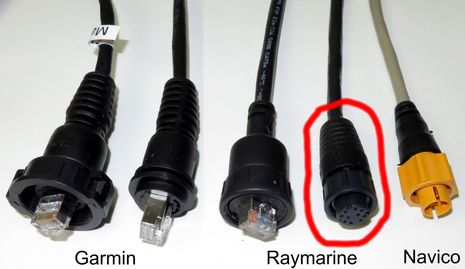

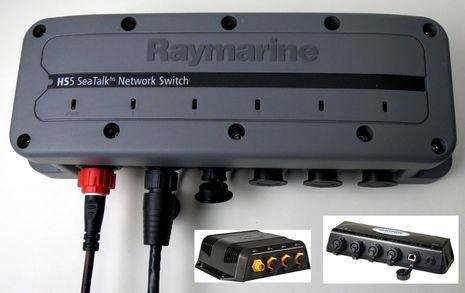
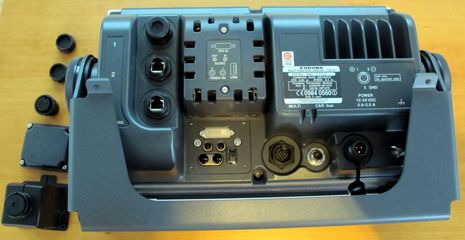
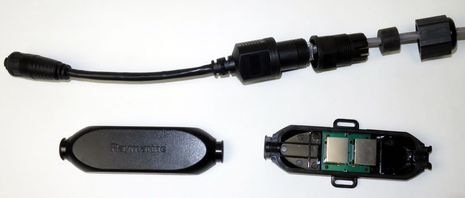


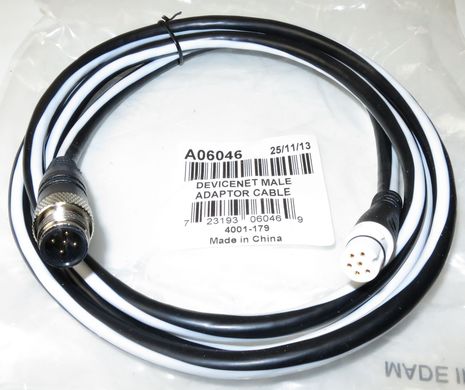











Are ethernet cables also susceptible to vibration in some way Ben? About once a month I need to get to the ethernet Raymarine SeaTalkhs switch, push the cables in and out, to clear the problem. Replacing the cables or using different ports on the hub made no improvement.
The problem surfaces when the two E-80 MFD’s start alarming complaining they don’t see each other.
OneNet please ASAP. Save us from this madness.
Dan, I guess what you’re saying is that you think you have a vibration problem. I’ve not heard of that before, and I’ve never had to re-seat the plugs into the SeaTalkhs switch.
But note Raymarine’s claim that the RayNet connector “replaces the RJ45 connector with a waterproof vibration tolerant twist pin connector that is designed for the marine environment.”
Ben, your description of Ethernet cable consisting of four pairs of solid wire is only partially correct, and primarily pertains to bulk cable intended for installations where there is no flexing or movement, like permanentl wiring of a house or business.
Ethernet patch cables (generally up to 100′ long), have stranded conductors and are far more flexible and durable. I think they are the proper choice for marine use. Many RJ45 crimp-on connectors accept either stranded or solid conductors, but there are also some designed for only one or the other. BTW, the easiest to crimp and get right 100% of the time are the EZ45 brand connectors.
Thanks, Karl! I know bloody little about Ethernet cable varieties, but I do gather that there are preferred types for marine use. It’s hard to find specifics but at least ABS seems to have standards regarding shielding and smoke emissions. These ABS approved Cat 5 and 6 cables seem to be 4 x 2 x 24 AWG unstranded:
http://www.fscglobal.com/Marine/Marine+Approved+Data+Cables/Marine+Approved+Data+Cables/list.htm
Maybe an installer out there can tell us what the bulk Garmin cable looks like inside:
https://buy.garmin.com/en-US/US/on-the-water/networking/marine-network-cable/prod1132.html
Ben,
The Garmin network cables are 4 twisted pair, shielded, Cat5E, 24AWG stranded, bare copper. The drain wire is tinned.
I usually use the Platinum Tools EZ-RJPRO HD CRIMP TOOL part #100054 and the shielded EZRJ 45’s part #100020.
EZRJ 45 #100020
http://www.pbase.com/mainecruising/image/155445373.jpg
EZ-RJPRO Crimp Tool #100054
http://www.pbase.com/mainecruising/image/155445374.jpg
RC Collins
Compass Marine
Thanks, RC! And here are some notes about RayNet connectors from the source:
“1. Our choice of connectors on RayNet was not just about waterproofing. Vibration resistance was huge consideration too. RJ45 pins are spring loaded and can bounce under high shock or vibration scenarios. The pins in RayNet hold fast and provide solid connectivity even under extreme shock and vibration scenarios.
2. We designed RayNet to be future proof. The extra cores in the RayNet cable are there to support Gigabit speed Ethernet, and also Power Over Ethernet (PoE). This way the cabling of today is already compatible with the products of tomorrow.”
I’ll add from reading the manual that port #5 on the HS5 SeaTalkHS switch already supports gigabit speeds so that two switches can be chained together.
Interesting to see the use of shielded CAT5e as it is quite rare in the US even at large server farms. Twisted pair generally provides better noise immunity than shielding alone, but combining the two adds another layer of protection. I have only installed shielded CAT5e in industrial applications such as CNC machine wiring and process control…never saw it in a business environment, ever.
Some CAT cable minutia: each of the four twisted pairs are twisted at a different pitch (turns per inch), primarily to eliminate cross-talk between pairs. Various inert filler materials can be used to insure precise spacing of the pairs from each other inside the jacket, a major problem with tight-radius bends, overly- ambitious tightening of cable tie wraps, or allowing cables to sag unsupported.
CAT6e probably marks the practical end of the evolution of Ethernet cables…higher required speeds will likely continue being done via fiber rather than copper. I think cost (and inertia) is the only thing holding it back for marine data transfer.
Karl,
Don’t confuse this level of shielding with what is typical in a VHF cable etc.. It is a simple aluminum/mylar shield, nothing fancy like you’d get in an LMR-400 cable….
Clarifying question Ben, apologies if I missed this point …
The RayNet cables are a Raymarine proprietary design and not based on any available or emerging standard, correct?
I’m not implying there are not good reasons that this be so. The reasons Ray provided are compelling if there are no COTS available standard connectors.
I could have been clearer about that, Sparky. To the best of my knowledge the RayNet connector is Raymarine’s own design, and I think the orange Navico Ethernet plug is the same story. There seem to be various manufacturers offering the waterproof collaring for standard RJ45 connectors — like this http://goo.gl/zJHweg — but I don’t think they are standardized or necessarily compatible.
Apparently there are some standard multi-manufacturer waterproof industrial Ethernet connectors, which is where the NMEA OneNet committee is looking. Discussed here: http://goo.gl/M3FH7X They’ll probably be expensive but NMEA is already showing an adaptor to RJ45, which will apparently be allowed in some circustances, and I imagine there might be OneNet to RayNet adaptors, etc.
All of the connectors shown are catalog-standard from typical manufacturers. The marine electronics folks aren’t really making proprietary connectors, just choosing different vendors and options.
If you are good with cable assembly (which often requires a significant investment in tools for some of the pin/socket connectors), you can chop off and re-connector pretty much any vendor’s cable (or build your own alternative). This can not only ease the difficulty of running the cables through the boat, but also avoid coils of excess cable piling up in places when the manufacturer’s options don’t match your need.
It does sometimes take a bit of research to find the right connector match, but the big distributors like Allied, Newark, Mouser and Digikey have a pretty good variety of options. Some of the European connectors are a little more trouble. In most cases, the connectors are typical industrial electronic parts, and are offered in a wide variety of options.
When I worked on Oil Rigs we always had a few Electronics Technicians onboard with racks of tools and adapters and the willingness to make me custom adapters, custom extension cords and such… boy do I miss that
FYI
Note that Garmin makes two different couplers
Marine Network Cable Coupler
Part Number: 010-10580-00
and
Marine Network Cable PoE Isolation Coupler
Part Number: 010-10580-10
Lowrance sells a cable that plugs (yellow) into their ethernet (NEP-2) or back of any of the higher end MFD’s that have the yellow ethernet plug. The other end accepts an RJ45. They have to have this as their wide band radar cable comes into the boat with an RJ45 which allows you to easily bring it down a sailboat mast.
Thanks, Bill! Actually there are at least three different Yellow Female Navico Ethernet to RJ45 Male adaptors and one is a crossover model, so folks should be careful:
http://store.navico.com/Simrad-Yachting-Accessories/Simrad-Yachting-Ethernet-Cables
Ben.
Yet another great article and discussion. As to your question In fact, if you look closely at the RayNet plug you’ll see that it has 10 pins, which is a minor mystery given the Ethernet norm of 8 wires. Does anyone have a guess about what those two extra pins do, or will eventually do?, do you have any answers yet?
Apparently you found an answer from Raymarine:
2. We designed RayNet to be future proof. The extra cores in the RayNet cable are there to support Gigabit speed Ethernet, and also Power Over Ethernet (PoE). This way the cabling of today is already compatible with the products of tomorrow.”
I finally found a good device for lightning surge protection for a CAT6 cable with RJ45 connectors that works for the Raymarine digital radar with a RJ45 network connector. However, if the connector is the new Raynet 10-pin plug then two Raynet-RJ45 adapters are required, and there is still the question as to what the other two connections do. In the digital radar I would guess nothing – yet. The same technique can be used to add surge protection in a Raynet 1Gbit/sec connection between network switches, which is highly desirable if the connection runs say from mast base to the helm, but the 8-line surge protector effectively open circuits the two remaining wires. So when Raymarine decides to use these this technique will be obsolete.
Does your crystal ball predict when the two extra cores will be used, if ever? It seems to me that fiber optics is the obvious way to get even more bandwidth, and POE has existed for some time.
Ewen.
Marine Lightning Protection
Thanks, Ewen! I really don’t know when or what Raymarine will do with those extra cores. But I am fairly certain that the current radars don’t use them. I think the radars are now shipping with RayNet connectors but I used the new RJ45-to-RayNet adaptor with the Ray HD radome I’ve testing for years and it worked fine. This weekend I used the same adapter with a FLIR M-Series thermal camera, also worked fine.
Of course I’m curious about the Ethernet surge protector you like, as other readers may be. Also enjoyed poking around your site and the extensive lightning research done by your twice-hit-but-little-damaged protection client Domino:
http://www.dominocatamaran.blogspot.com
(search “lightning”)
Bump.
I’ve got an issue re: running a Navico Ethernet cable through a steering pedestal (Zeus2 to NEP-2 connection).
Navico connector will not fit. Cable will have to be cut. I’m heading towards a solution of connecting an rj45 to the cut end, then using the Navico rj45 to Ethernet adapter (connection will be below decks and relatively sheltered) .
Good plan? Alternative?
That, or just put RJ45 connectors on both cut ends and use an RJ45 coupler. You can even get waterproof ones. Or if you want to be on the leading edge, use D-coded M12 connectors which are an industrial Ethernet standard.
http://www.iebmedia.com/index.php?id=5873&parentid=63&themeid=255&showdetail=true
It’s also discussed in other Panbo entries.
The M12 4p D-coded and M12 8p X-coded (Gb) are pretty standard for factory equipment. Those are as well the connectors proposed for OneNet.
Humminbird is using another variant for their Ethernet bus (MFD, Sounder, Radar):
M12 8p A-coded.
Just to add an animal more to the zoo…
Hubert
I bet the 2 extra wires (10pin – rj45(8)= 2. Probably system-wide ‘power on/off’ signal to all network nodes….I2c ?